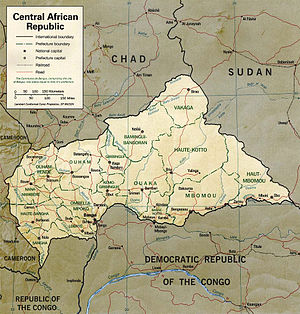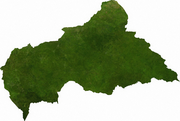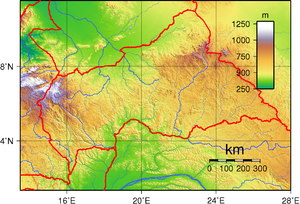
Geography of the Central African Republic
Background Information
This wikipedia selection has been chosen by volunteers helping SOS Children from Wikipedia for this Wikipedia Selection for schools. Sponsor a child to make a real difference.
Location: Central Africa, north of Democratic Republic of the Congo
Geographic coordinates: 7°N 21°E
Map references: Africa
Area:
total: 622,984 km²
land: 622,984 km²
water: 0 km²
Area - comparative:
- Canada: slightly smaller than Manitoba
- US: slightly smaller than Texas
Land boundaries:
total: 5,203 km
border countries: Cameroon 797 km, Chad 1,197 km, Democratic Republic of the Congo 1,577 km, Republic of the Congo 467 km, Sudan 1,165 km
Coastline: 0 km (landlocked)
Maritime claims: none (landlocked)
Terrain: vast, flat to rolling, monotonous plateau; scattered hills in northeast and southwest
Elevation extremes:
lowest point: Oubangui River 335 m
highest point: Mont Ngaoui 1,420 m
Natural resources: diamonds, uranium, timber, gold, petroleum, hydropower
Land use:
arable land: 3%
permanent crops: 0%
permanent pastures: 5%
forests and woodland: 75%
other: 17% (1993 est.)
Irrigated land: 20 km² (2003)
Total renewable water resources: 144.4 km3 (2003)
Natural hazards: hot, dry, dusty harmattan winds affect northern areas; floods are common
Environment - current issues: tap water is not potable; poaching has diminished its reputation as one of the last great wildlife refuges; desertification; deforestation
Environment - international agreements:
party to: Biodiversity, Climate Change, Desertification, Endangered Species, Nuclear Test Ban, Ozone Layer Protection, Tropical Timber 94
signed, but not ratified: Law of the Sea
Geography - note: landlocked; almost the precise centre of Africa
The Central African Republic is a land-locked nation within the interior of the African continent. It is bordered by the countries of Cameroon, Chad, the Sudan, the Democratic Republic of the Congo and the Republic of the Congo. Much of the country consists of flat, or rolling plateau savanna, typically about 1,640 feet (500 m) above sea level. In the northeast are the Fertit Hills, and there are scattered hills in southwest part of the country. To the northwest is the Yade Massif, a granite plateau with an altitude of 3,750 feet (1,143 m).
At 240,519 square miles (622,941 km2), the Central African Republic is the world's 43rd-largest country (after Somalia). It is comparable in size to Ukraine, and is somewhat smaller than the US state of Texas.
Much of the southern border is formed by tributaries of the Congo River, with the Mbomou River in the east merging with the Uele River to form the Ubangi River. In the west, the Sangha River flows through part of the country. The eastern border lies along the edge of the Nile river watershed.
Estimates of the amount of the country covered by forest ranges up to 8%, with the densest parts in the south. The forest is highly diverse, and includes commercially important species of Ayous, Sapelli and Sipo. The deforestation rate is 0.4% per annum, and lumber poaching is commonplace.
Climate
Tropical; hot, dry winters; mild to hot, wet summers The climate of the C.A.R. is generally tropical. The northern areas are subject to harmattan winds, which are hot, dry, and carry dust. The northern regions have been subject to desertification, and the northeast is desert. The remainder of the country is prone to flooding from nearby rivers.



